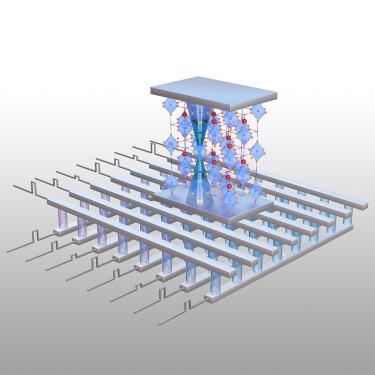用于图像处理和模式识别的空位有序双过氧化物忆阻器
IF 17.5
1区 材料科学
Q1 MATERIALS SCIENCE, MULTIDISCIPLINARY
引用次数: 0
摘要
高性能忆阻器已成为集成噪声图像识别和降噪功能的高效硬件。在此,我们报告了一种快速开关忆阻器,它采用空位有序双包晶Cs2TiBr6纳米晶体制造,具有数十纳秒的开关时间。双包晶石中的空间有序空位促进了导电丝的可预测形成和断裂,我们利用有限元分析物理模型对其进行了全面模拟。这些独特的微观特征抑制了导电丝的随机生长,并增强了溴空位扩散,从而提高了忆阻器的开关速度。对类似突触行为的进一步研究表明,基于 Cs2TiBr6 的忆阻器具有很高的鲁棒性和可重复性。我们进一步开发了用于图像去噪和分类的人工神经网络交叉阵列忆阻器,使预变色图像的识别准确率比未变色样本提高了 10%。我们的工作凸显了本征空位有序忆阻器材料在推进高效、实时、稳健视觉识别方面的潜力。本文章由计算机程序翻译,如有差异,请以英文原文为准。


Vacancy-ordered double-perovskite-based memristors for image processing and pattern recognition
High-performance memristors have emerged as efficient hardware for integrating noisy image recognition and noise reduction. Herein, we report a fast-switching memristor featuring tens of nanoseconds switching time fabricated using a vacancy-ordered double perovskite, Cs2TiBr6 nanocrystals. The spatially ordered vacancies in the double perovskite facilitate the predictable formation and rupture of conductive filaments, which are explored through a comprehensive simulation using the finite element analysis physical model. These unique microscopic features suppress random conducting filament growth and enhance bromine vacancy diffusion, boosting memristor switching speed. A further study of synapse-like behaviors reveals that Cs2TiBr6-based memristors exhibit high robustness and reproducibility. We further developed the crossbar-array memristors as artificial neural networks for image denoising and classification, achieving a 10% increase in recognition accuracy for pre-denoised images over non-denoised samples. Our work highlights the potential of intrinsic vacancy-ordered memristive materials for advancing efficient, real-time, robust visual recognition.
求助全文
通过发布文献求助,成功后即可免费获取论文全文。
去求助
来源期刊

Matter
MATERIALS SCIENCE, MULTIDISCIPLINARY-
CiteScore
26.30
自引率
2.60%
发文量
367
期刊介绍:
Matter, a monthly journal affiliated with Cell, spans the broad field of materials science from nano to macro levels,covering fundamentals to applications. Embracing groundbreaking technologies,it includes full-length research articles,reviews, perspectives,previews, opinions, personnel stories, and general editorial content.
Matter aims to be the primary resource for researchers in academia and industry, inspiring the next generation of materials scientists.
 求助内容:
求助内容: 应助结果提醒方式:
应助结果提醒方式:


